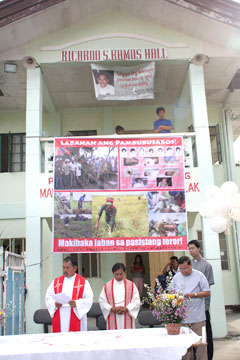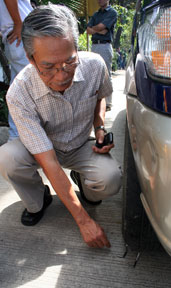Luisita
massacre 2nd anniversary
Fight For Land and
Justice Continues
They came back, not in
the thousands as they did when the massacre occurred two years ago, but
with the same fervor to continue their struggle for land and justice in
Hacienda Luisita.
BY ABNER BOLOS
Gitnang Luzon News Service
Posted by Bulatlat
TARLAC CITY - They came back, not in the
thousands as they did when the massacre occurred two years ago, but with
the same fervor to continue their struggle for land and justice in
Hacienda Luisita this city, some 120 kilometers north of Manila.

IRONY:
Pictures of the Hacienda Luisita martyrs, laid at Gate 1 of the
Central Azucarera de Tarlac Nov. 16 while soldiers and Blue guards
prevent people from commemorating the massacre that happened two years
ago
PHOTO By DABET CASTAÑEDA |
A black granite memorial shrine now stands
in Gate 1 of the vast estate’s sugar mill. It bore the names of 13 of the
15 people who were killed in the course of the controversial labor dispute
that pitted the family of former president Corazon Cojuangco-Aquino and
about 6,000 plantation and sugar mill workers.
Wreaths and candles
Last November 16, as company guards and
police watched warily, the workers, their families and supporters laid
wreaths and lighted candles on the shrine to mark the 2nd
anniversary of the massacre.
|
On the shrine were the words “Ang
kanilang buhay ay ginintuang alay para sa mamamayan ng Hacienda Luisita sa
kanilang makatwirang pakikipaglaban para sa lupa, sahod at karapatan”
(Their lives are a golden offering for the people of Hacienda Luisita in
their just struggle for land, jobs and justice).
The sugar cane harvest season begun a week
ago and the sugar mill is in full operation. Trucks loaded with sugar cane
are lined up at the mill entrance waiting for their turn to unload. Some
are parked on the vacant lot in front of the gate where the barricades
stood during the strike.
On this spot, seven strikers were killed
when soldiers and police fired at protesters manning the barricades at the
height of the strike exactly two years ago. Thirteen months later, the
strike ended with the workers claiming victory.
But not before six union leaders and
supporters were likewise assassinated one after another. After the
barricades were lifted in December 2005, two more leaders, Tirso Cruz, a
Luisita union leader and Aglipayan bishop Alberto Ramento, an outspoken
supporter of the workers were killed.
Aside from the killings, soldiers have
been blamed for several cases of abductions, torture, physical and mental
abuse, harassments and other human rights violations which did not stop
when the strike ended. Cases have been filed in court against the
soldiers.

A concelebrated mass is held at the
Ricardo S. Ramos hall in Brgy. Mapalacsiao, Hacienda Luisita, Tarlac.
The hall was named before Ramos, slain CATLU president who was also
Mapalacsiao’s Barangay captain at the time of his death.
PHOTO By DABET CASTAÑEDA |
At high noon last Thursday, after a brief
stop in Gate 1, the entourage that included Bayan Muna representative
Satur Ocampo, leaders of the Bagong Alyansang Makabayan (Bayan or New
Patriotic Alliance), human rights organizations and a Canadian
fact-finding mission proceeded to the Mapalacsiao barangay (village) hall
where they held the program.
(The workers have asked permission from
the company to hold commemorative rites in Gate 1 but they were allowed
only two hours—from 1 to 3 p.m., too short a time for the program planned
by the workers.)
Conflict
The strike-related killings reflect the
depth of the conflict in the hacienda that persists today, almost a year
after the strike ended.
At the core of the conflict is the
ownership of the 6,000-ha. sugar plantation.
The Cojuangco family acquired the hacienda
from the Spanish owners in 1958 through loans guaranteed by the Philippine
government—a move that the workers say derailed their petition for land
distribution at that time.
After the acquisition, the workers waited
for the implementation of a provision in an agreement in one of the loan
packages that required the Cojuangco family to distribute the land to the
farm workers after 10 years.
|
Failing to implement the agreement, the
Cojuangco family became defendants in a law suit. In December 1985, the
court ruled in favor of the farm workers but their hopes were dashed when
Corazon Cojuangco-Aquino was catapulted to the presidency after the
February 1986 popular uprising.
As president, Corazon Cojuangco-Aquino
declared land reform as her centerpiece program and implemented the stock
distribution plan (SDP) in the hacienda in 1988 under the Comprehensive
Agrarian Reform Program (CARP).
Last straw
The SDP proved to be the last straw in the
contentious relations between the workers and the Cojuangco family. Under
the SDP, stock certificates were distributed instead of land.
After 15 years, the farm workers found
themselves with only a day’s work each week and were being laid-off en
masse. Almost 2,000 hectares have also been carved out of the hacienda by
this time and converted to non-agricultural use.
On Nov. 6, 2004 the plantation and sugar
mill workers went on strike over the termination of union officers and low
wages and benefits. But they knew that the SDP is the cause of their
troubles and they also demanded that it be revoked and that land reform be
implemented in the hacienda.
During the strike, most if not all the
residents in the 10 villages comprising the hacienda threw their support
behind the striking workers.

SABOTAGED: Bayan Muna
Rep. Satur Ocampo shows how metal spikes caused the delay of the
15-vehicle caravan.
PHOTO By DABET CASTAÑEDA |
On the day of the massacre, some 15,000
workers and their supporters massed at the gates of the sugar mill and in
more than 10 barricades surrounding the factory and faced a phalanx of
more than 1,000 soldiers, police and company guards.
The government has regarded the Luisita
dispute as a “matter of national security” and has deployed military units
in the villages where they remain until today. These were the very same
soldiers who, together with police forces, fired on the strikers resulting
in the Hacienda Luisita massacre.
In December last year, the Presidential
Agrarian Reform Council ruled that the Cojuangco family violated
provisions in the SDP and placed the hacienda under land distribution.
The decision, acknowledged by the workers
as their victory, still stands today but was temporarily stalled by a
temporary restraining order issued by the Supreme Court last June.
Mapalacsiao
Mapalacsiao (pop. 10,000), is one of 10
villages in the hacienda located just a kilometer away from the massacre
site. It has also become a battle ground for the parties in conflict.
|
The village hall is now named after
Ricardo Ramos, village chairman and president of the Central Azucarera de
Tarlac Labor Union, the sugar mill workers’ union. Ramos, the 13th
Luisita martyr, was gunned down in the village allegedly by soldiers on
Oct. 25, 2005.
Aside from being a key strike leader,
Ramos opposed the deployment of soldiers in the village and led residents
in forming human barricades to protest the construction of the
Subic-Clark-Tarlac Expressway Project (SCTEP) that cuts across the village and the
entire hacienda.
At the façade of the village hall behind
the makeshift altar where the commemorative mass was held hangs a
tarpaulin mural depicting the struggle of the workers and their triumph in
finally being able to till the land for their own use.
Stalks of newly-harvested rice, vegetables
and sugar cane were on display to show that their lives now, after
implementing “people’s land reform,” are better than when they were
ill-paid wage earners.
The workers said that since the strike,
more than 1,000 hectares were gradually turned into farms planted with
food crops by the workers and their families.
The Cojuangco family can only watch as
farm workers and their families started cultivating idle land during the
height of the strike. With the SDP revoked and the issue of land
distribution once again in the courts, the farm workers continued to
expand cultivation.
Search for justice
“We will not rest until justice for the
victims is achieved,’ said Romeo Ramos, brother of the slain labor leader.
He said not one of the suspects has been arrested and blames the Cojuangco
family and the government for master-minding the killings and coddling the
suspects.
Roman Catholic Bishop Florentino Cinense
said in his homily during the ecumenical mass that the search for truth
and justice must continue although “the methods on how these can be
achieved may sometimes be different.”
“The real meaning of paying tribute to the
memory of our martyrs is for us to persevere and continue with the
struggle for land, jobs and justice,” Rene Galang, president of the United
Luisita Workers’ Union (ULWU), said in a statement.
Galang led the 5,000-strong plantation
workers’ union but he had to leave the hacienda and seek sanctuary
elsewhere when the strike ended because of serious threats on his life.
Uneasy peace
With the high stakes at hand, both parties
are still locked in a virtual life and death struggle. The tension between
civilians and the military lingers and occasionally disturbs the uneasy
peace in the hacienda.
In fact, days before November 16, the
residents reported that military check points were placed on roads leading
to the sugar mill. Workers who went around the villages to invite people
to join the commemoration also reported that they were harassed by the
military.
The caravan of some 15 vehicles of the
contingent from Metro Manila and the Central Luzon provinces was
confronted by police in San Fernando, Pampanga.
Three of the vehicles in the caravan
suffered flat tires due to metal spikes strewn by military agents along
the road, according to Joseph Canlas, chair of the Alyansa ng mga
Magbubukid sa Gitnang Luzon (AMGL or Alliance of Peasants in Central
Luzon).
“The workers were left with no choice but
to continue fighting. The repression they experience everyday proves that
the government and the Cojuangco family want to perpetuate land monopoly,”
Canlas said. Gitnang Luzon News Service/Posted by Bulatlat
BACK TO
TOP ■
PRINTER-FRIENDLY VERSION ■
COMMENT
© 2006 Bulatlat
■
Alipato Media Center
Permission is granted to reprint or redistribute this article, provided
its author/s and Bulatlat are properly credited and notified.